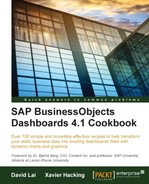SAP BusinessObjects Dashboards 4.1 (formerly known as Xcelsius) is a desktop dashboard and visualization solution that is a core part of SAP BusinessObjects BI 4.1. Once a user creates a dashboard model, it can be deployed in Flash format to web portals, SAP environments, the SAP BusinessObjects BI Platform, and desktop applications such as PowerPoint, Word, or PDF.
For dashboard designers/developers, SAP BusinessObjects Dashboards allows for rapid development of data visualizations through a flexible and easy-to-use graphical user interface.
Using SAP BusinessObjects Dashboards, we can accomplish the following:
- Create interactive dashboards that have a wow factor unlike other dashboard tool competitors.
- Connect dashboards to over 10 different types of data connections.
- Integration and interoperability with existing SAP BusinessObjects BI content.
- We can embed our dashboards into a variety of different formats to allow for convenient sharing between users.
- Ability to create custom add-on components using the SAP BusinessObjects Dashboards SDK.
SAP BusinessObjects Dashboards in its original conception was a way to build visualizations and dashboards using Excel data. That is also where the original name Xcelsius comes from. Over the past decade, BusinessObjects has enhanced Xcelsius into a fully featured enterprise-ready dashboard solution that works with any data source.
After the acquisition of BusinessObjects by SAP, the mission to make Xcelsius a dashboard product to serve all its customers (beyond being just a personal productivity tool) continued. The BI market and SAP customers were also demanding an enterprise dashboard solution for the types of projects they were using Xcelsius for, for example, dashboards for thousands of users using large data warehouses as a datasource. The name Xcelsius was no longer meaningful or relevant.
By changing the name Xcelsius to SAP BusinessObjects Dashboards, SAP is showing its commitment to delivering a solution that serves the needs of all BI customers as well as aligning the name to the product's growing capabilities and roadmap.
The SAP BusinessObjects Dashboards portfolio consists of several different packages (see the edition comparison later in the preface). In this book, we use SAP BusinessObjects Dashboards to refer to the tool itself.
Chapter 1, Staying in Control, presents you with best practices for using the SAP BusinessObjects Dashboards spreadsheet, the data model, and connections with the components on the canvas.
Chapter 2, Data Visualization, presents you with recipes on how to use different components such as charts, tables, and graphs to visualize data on the dashboard.
Chapter 3, From a Static to an Interactive Dashboard, shows you how to add interactivity to your dashboards by adding selectors, maps, buttons, drilldowns, and so on.
Chapter 4, Dynamic Visibility, shows you how to make components visible/invisible and provides scenarios where dynamic visibility becomes useful.
Chapter 5, Using Alerts, contains examples of different ways of showing alerts on a dashboard.
Chapter 6, Advanced Components, provides recipes on SAP BusinessObjects Dashboards' more advanced components.
Chapter 7, Dashboard Look and Feel, teaches you how to tweak the visuals and user experience of the dashboard by customizing the look of components.
Chapter 8, Dashboard Data Connectivity, talks about the various options to connect a dashboard to external data sources.
Chapter 9, Exporting and Publishing, contains recipes on how to export SAP BusinessObjects Dashboards into different environments.
Chapter 10, Top Third-party Add-ons, contains an introduction to some of the most useful third-party add-ons for SAP BusinessObjects Dashboards.
Chapter 11, Performance Tuning, teaches you how to improve the performance of your dashboards by tweaking the spreadsheet and optimizing the data sources' connection setup.
Chapter 12, Increasing Productivity, discusses various development best practices and tips to save precious development time.
Appendix A, Real-world Dashboard Case Studies, demonstrates how to implement various techniques covered in this book by creating two applications: a calculator that displays monthly payments of a mortgage and a sales/profit dashboard that displays the sales or profit of each state on a map.
Appendix B, Additional Resources – Supported Excel Functions and System/Software Requirements, lists some helpful online resources for further reference and some useful Microsoft Excel functions supported by SAP BusinessObjects Dashboards.
Appendix C, The Future of Dashboarding with SAP Design Studio, introduces you to a new SAP tool: Design Studio. A comparison with SAP BusinessObjects Dashboards is made and the future roadmap for this tool is shared.
